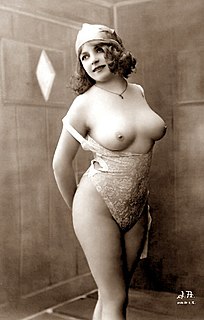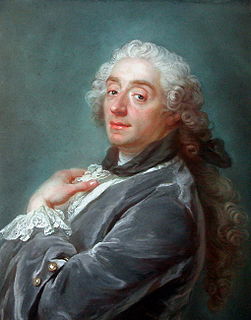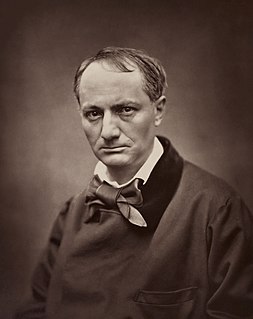
Erotica is any artistic work that deals substantively with subject matter that is erotically stimulating or sexually arousing but is not pornographic. Erotic art may use any artistic form to depict erotic content, including painting, sculpture, drama, film or music. Erotic literature and erotic photography have become genres in their own right.
Heterosexuality is romantic attraction, sexual attraction or sexual behavior between persons of the opposite sex or gender. As a sexual orientation, heterosexuality is "an enduring pattern of emotional, romantic, and/or sexual attractions" to persons of the opposite sex; it "also refers to a person's sense of identity based on those attractions, related behaviors, and membership in a community of others who share those attractions."

Eroticism is a quality that causes sexual feelings, as well as a philosophical contemplation concerning the aesthetics of sexual desire, sensuality, and romantic love. That quality may be found in any form of artwork, including painting, sculpture, photography, drama, film, music, or literature. It may also be found in advertising. The term may also refer to a state of sexual arousal or anticipation of such – an insistent sexual impulse, desire, or pattern of thoughts.

Pornography in Japan is a large and intertwined business of adult entertainment with unique characteristics that readily distinguish it from Western pornography. Reflecting Japan's views on sexuality and culture, Japanese pornography delves into a wide spectrum of heterosexual, homosexual, and transgender sexual acts in addition to unique fetishes and paraphilias.

A facial is a sexual activity in which a man ejaculates semen onto the face of one or more sexual partners. A facial is a form of non-penetrative sex, though it is generally performed after some other means of sexual stimulation, such as vaginal sex, anal sex, oral sex or masturbation. Facials are currently regularly portrayed in pornographic films and videos, often as a way to close a scene.

Gay-for-pay describes male or female actors, pornographic stars, or sex workers who identify as heterosexual but who are paid to act or perform as homosexual professionally. The term has also applied to other professions and even companies trying to appeal to a gay demographic. The stigma of being gay or labeled as such has steadily eroded since the Stonewall riots began the modern American gay rights movement in 1969. Through the 1990s, mainstream movie and television actors have been more willing to portray homosexuality, as the threat of any backlash against their careers has lessened and society's acceptance of gay and lesbian people has increased.
Romantic and/or sexual attraction to transgender people can be toward trans men, trans women, non-binary people, or a combination of these. This attraction can be a person's occasional, or exclusive interest.

Pornography is the portrayal of sexual subject matter for the exclusive purpose of sexual arousal. Pornography may be presented in a variety of media, including books, magazines, postcards, photographs, sculpture, drawing, painting, animation, sound recording, writing, film, video, and video games. The term applies to the depiction of the act rather than the act itself, and so does not include live exhibitions like sex shows and striptease. The primary subjects of present-day pornographic depictions are pornographic models, who pose for still photographs, and pornographic actors or "porn stars", who perform in pornographic films. If dramatic skills are not involved, a performer in pornographic media may also be called a model.
Transgender sexuality is the sexuality of transgender people.
Women’s erotica is any erotic material that caters specifically to women target-demographic of various sexual preferences. When erotica is specifically directed at lesbians, it is referred to as lesbian erotica. Women's erotica is available from a variety of media including video games, websites, books, comics, short stories, films, photography, magazines, audio, anime and manga. The content may cover many aspects of sexuality, from relationships to fetishes; the main idea being to convey sex-positivism from a woman’s perspective, or to feature female empowerment and sexual fantasies.
Feminist sexology is an offshoot of traditional studies of sexology that focuses on the intersectionality of sex and gender in relation to the sexual lives of women. Sexology has a basis in psychoanalysis, specifically Freudian theory, which played a big role in early sexology. This reactionary field of feminist sexology seeks to be inclusive of experiences of sexuality and break down the problematic ideas that have been expressed by sexology in the past. Feminist sexology shares many principles with the overarching field of sexology; in particular, it does not try to prescribe a certain path or "normality" for women's sexuality, but only observe and note the different and varied ways in which women express their sexuality. It is a young field, but one that is growing rapidly.

Gay pornography is the representation of sexual activity between males. Its primary goal is sexual arousal in its audience. Softcore gay pornography also exists; it at one time constituted the genre, and may be produced as beefcake pornography for heterosexual female and homosexual male consumption.

Bisexuality is romantic attraction, sexual attraction, or sexual behavior toward both males and females, or to more than one sex or gender. It may also be defined as romantic or sexual attraction to people of any sex or gender identity, which is also known as pansexuality.
Sexual fluidity is one or more changes in sexuality or sexual identity. There is significant debate over whether sexuality is stable throughout life or is fluid and malleable. Scientific consensus is that sexual orientation, unlike sexual orientation identity, is not a choice - i.e. that cannot be changed at will. While scientists generally believe that sexual orientation is usually stable, sexual identity can change throughout an individual's life, and may or may not align with biological sex, sexual behavior or actual sexual orientation. There is no consensus on the exact cause of developing a sexual orientation, but genetic, hormonal, social and cultural influences have been examined. Scientists believe that it is caused by a complex interplay of genetic, hormonal, and environmental influences.
Queer pornography depicts performers with various gender identities and sexual orientations interacting and exploring genres of desire and pleasure in unique ways. These conveyed interactions distinctively seek to challenge the conventional modes of portraying and experiencing sexually explicit content. Scholar Ingrid Ryberg additionally includes two main objectives of queer pornography in her definition as "interrogating and troubling gender and sexual categories and aiming at sexual arousal."
The following outline is provided as an overview of and topical guide to human sexuality:
Feminist views on sexuality widely vary. Many feminists, particularly radical feminists, are highly critical of what they see as sexual objectification and sexual exploitation in the media and society. Radical feminists are often opposed to the sex industry, including opposition to prostitution and pornography. Other feminists define themselves as sex-positive feminists and believe that a wide variety of expressions of female sexuality can be empowering to women when they are freely chosen. Some feminists support efforts to reform the sex industry to become less sexist, such as the feminist pornography movement.
Women's pornography, sometimes referred to as sex-positive pornography, is pornography often produced by women and aimed specifically at the female market – rejecting the view that pornography is only for men.
Victorian erotica is genre of sexual art and literature which emerged in the Victorian Era of 19th century Britain. Victorian erotica emerged as a product of a Victorian sexual culture. The Victorian era was characterised by paradox of rigid morality and anti-sensualism, but also by an obsession with sex. Sex was a main social topic, with progressive and enlightened thought pushing for sexual restriction and repression. Overpopulation was a societal concern for the Victorians, thought to be the cause of famine, disease, and war. To curb the threats of overpopulation, sex was socially regulated and controlled. New sexual categories emerged as a response, defining normal and abnormal sex. Heterosexual sex between married couples became the only form of sex socially and morally permissible. Sexual pleasure and desire beyond heterosexual marriage was labelled as deviant, considered to be sinful and sinister. Such deviant forms included as masturbation, homosexuality, prostitution, and pornography. Procreation was the primary goal of sex, removing it from the public, and placing it in the domestic. Yet, Victorian anti-sexual attitudes were contradictory of genuine Victorian life, with sex underlying much of the cultural practice. Sex was simultaneously repressed and proliferated. Sex was featured in medical manuals such as The Sexual Impulse by Havelock Ellis and Functions and Disorders of ReproductiveOrgans by William Acton, and in cultural magazines like The Penny Magazine, and The Rambler. Sex was popular in entertainment, with much of Victorian theatre, art and literature, including and expressing sexual and sensual themes
































